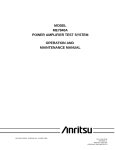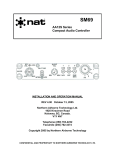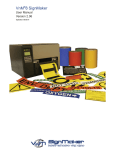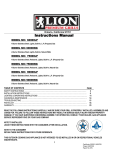Download PRECISION TEST SYSTEMS PTS50 Instruction & Service
Transcript
PRECISION TEST SYSTEMS PTS50 10 MHz DISTRIBUTION AMPLIFIER INSTRUCTION / SERVICE MANUAL Rev. 10.0 May 2005 PTS50 Operators Manual. © Precision Test Systems 1998 - 2005 1 TABLE OF CONTENTS Section 1 1.1 Warranty 1.2 Claim for damage in shipment 1.3 Claim under warranty 1.4 Service / Repairs 1.5 Safety Information 1.6 Cleaning Information and Preventative Maintenance Section 2 Specifications Section 3 Description of controls Section 4 Operation Section 5 Theory of Operation Section 6 Options Section 7 Performance Check and Realignment procedure PTS50 Operators Manual. © Precision Test Systems 1998 - 2005 2 SECTION 1 GENERAL 1.1 Warranty Precision Test System warrants each of the instruments of their manufacture to be free from defects in material and workmanship for a period of one year from date of original purchase. The foregoing is in lieu of any other warranty, express, implied, or statutory. Precision Test Systems will repair or replace any instrument found defective. This warranty may not apply to instruments that, in the opinion of Precision Test Systems, have been altered or misused. 1.2 Claims for Damage in Shipment The PTS50 should be inspected as soon as it is received. If the instrument is damaged in any way, or fails to operate properly, please advise Precision Test Systems immediately. 1.3 Claims under Warranty If the PTS50 does not perform correctly within the warranty period, it must be returned to Precision Test Systems for repair. However, before sending it back to Precision Test Systems, please phone, fax or email them to discuss the fault. Many faults are actually operator problems. When sending it back, please pack it securely. Include a detailed report of the customer name, contact name, telephone/fax numbers and e-mail address, and the exact faults that are being experienced. Precision Test Systems contact details are as follows: Head Office - UK Precision Test Systems LTD 40 Holkham Avenue South Wooden Ferrers Chelmsford, Essex CM3 7AU, England Tel: +44 (0) 845 052 0920 Fax: +44 (0) 870 135 4973 Email: [email protected] Web: www.ptsyst.com South Africa Precision Test Systems cc Unit 2, Edison Park 183 Edison Crescent Hennops Park X7 Pretoria, South Africa Tel: +27 (0) 12 653 5848 Fax: +27 (0) 12 653 5848 Email: [email protected] Web: www.ptsyst.com USA Precision Test Systems Suite # 981 14781 Memorial Drive Houston Texas, 77079 Tel: 1 888 876 4804 Fax: 1 413 410 1112 Email: [email protected] Web: www.ptsyst.com Refer to the web site www.ptsyst.com for contact details of Precision Test’s branches/agents in different parts of the world. 1.4 Service / Repair The PTS50 should not normally need annual calibration. However, if realignment is needed, it is best performed by Precision Test Systems, who have the equipment and expertise to carry out any adjustments. The charge for a full calibration is two hours labor. Contact Precision Test Systems for the latest hourly labor charges. Please include a detailed fault report together with full details of the customer's name and contact phone/fax numbers and e-mail address. PTS50 Operators Manual. © Precision Test Systems 1998 - 2005 3 1.5 Safety Information The PTS50 is Installation Category II, Pollution degree 2. The PTS50 operates off a 115 / 230 VAC mains supply. Therefore high voltages exist in the unit. The following precautions should be observed: • • • • • • 1.6 Only qualified service personnel should remove the covers. Remove the power cord when opening the covers or changing the voltage selection. Never work alone when dealing with high voltage or mains supplies. Do not exceed the maximum ratings of the input and output connectors. Refer to this manual for more details of maximum ratings. The PTS50’s power switch is located on the rear panel. Therefore always position the PTS50 so easy access can be gained to this On/Off switch. The PTS50 must be grounded, by means of the supplied power cord. Cleaning Information and Preventative Maintenance The case of the PTS50 should be cleaned with a damp cloth soaked in water. No other cleaning materials should be used. There is no preventative maintenance, except from not exceeding any of the ratings for the connectors of the PTS50. PTS50 Operators Manual. © Precision Test Systems 1998 - 2005 4 SECTION 2 SPECIFICATIONS Specification Parameter Specification Input Comments Frequency 10.000 MHz or 5.000 MHz Bandwidth (-3 dB) > ± 250 kHz with a 10 MHz input > ± 125 kHz with a 5 MHz input Impedance 50 Ω Input VSWR < 1.15 @ 10 MHz Input Level Range (10 MHz input) +20 dBm to -10 dBm +20 dBm to -30 dBm Output Changes by < 0.4 dB Output Changes by < 5.0 dB Input Level Range (5 MHz input) +20 dBm to -5 dBm Output Changes by < 1 dB Output Waveform Sinewave Output Frequency Exactly the same as the input frequency Impedance 50 Ω Outputs 1 to 5 Front Panel BNC Connector VSWR < 1.5 @ 10 MHz Output level (10 MHz input @ input level -10 dBm or higher) From 0 dBm to +13 dBm Each output separately adjustable by internal potentiometer Output level with a 5 MHz input From -6 dBm to +7 dBm Each output separately adjustable by internal potentiometer Harmonic Distortion at 10 MHz -70 dBc Output set to +10 dBm Channel to Channel Isolation > 55 dB 0 dBm input. +10 dBm output. Output to Input Isolation > 90 dB Typically 93 to 117 dB Output 6 Output Waveform Squarewave Front Panel BNC Connector Level 0 V to +5 V nominal into open circuit 0 V to +2.7 V nominal into 50 Ω TTL Compatible TTL Compatible Frequency 10,5,2,1 MHz, 100 kHz and 1 Hz 1 Hz = 1 pulse per second Risetime < 25 ns At 1 MHz Output Waveform Sinewave Output Frequency Exactly the same as the input frequency Output 7 Rear Panel BNC Connector Frequency 10 MHz Level > -5 dBm Output level is fixed Harmonic Distortion -40 dBm Typical At 1 Hz Offset -106 dBc/Hz Measurement uncertainty ± 4 dB At 10 Hz Offset -130 dBc/Hz Measurement uncertainty ± 4 dB At 100 Hz Offset -140 dBc/Hz Measurement uncertainty ± 4 dB At 1 kHz Offset -145 dBc/Hz Measurement uncertainty ± 4 dB At 10 k Hz Offset -152 dBc/Hz Measurement uncertainty ± 4 dB At 100 kHz Offset -152 dBc/Hz Measurement uncertainty ± 4 dB At 1 MHz Offset -155 dBc/Hz Measurement uncertainty ± 4 dB Option 01: 19” Rack Mount PTS50 supplied in 19” rack mount case All connections on rear panel +5V No Alarm, 0V On Alarm 1kΩ Source Impedance Phase Noise (Typical) Options Option 02: NIST/UKAS Calibration Option 03A: TTL Alarm Output PTS50 Operators Manual. © Precision Test Systems 1998 - 2005 5 Option 04: 5 MHz input optimization Sensitivity increased to -10 dBm at 5 MHz Power (AC) 115 VAC or 230 VAC ± 10% 15 watts max Power (DC) 11-13 VDC @ 0.7 Amps Fuse Type 200mA slow blow for 115 VAC 100 mA slow blow for 230 VAC Size 215 mm wide x 265 mm deep x 35 mm high Weight 2.6 kg Ambient Operating Temperature -10 °C to +40 °C Storage Temperature -20 °C to +70 °C 10 MHz sensitivity remains unchanged General Selectable on rear panel Fuse 20 mm, 250 V rating PTS50 Operators Manual. © Precision Test Systems 1998 - 2005 6 SECTION 3 DESCRIPTION 3.1 Description The PTS50 can be used to synchronize up to six instruments to a 5 MHz or 10 MHz reference input. AGC control means a 10 MHz input can be varied from - 10 dBm to + 20 dBm without the output amplitude changing by more than 0.4 dB. The pure sinewave output means that the PTS50 will work in the most demanding applications. Harmonics are at least –70 dBc. A squarewave output can be switched in frequency to 10 MHz, 5 MHz, 2 MHz, 1 MHz, 100 kHz and 1 Hz. This output is ideal for instruments that do not use a 10 MHz timebase. A rear slave output can be connected to a second or multiple PTS50’s for up to 12 outputs or more. A dual colored LED on the front panel shines Red when power (either AC or DC) is applied to the unit and Green when both power and a valid input signal is applied. Options include alarm TTL output and redundancy. The TTL output is high when there is an input signal and low when there is no input signal. In a redundant system, two PTS50’s are wired in such a manner that one PTS50 supplies the output signal. In the event that this PTS50 fails, the second PTS50 automatically switches in to continue providing an output. This option ideal for high reliability systems. The PTS50 is housed in a steel case and operates from a 115 V or 230 V AC supply or external 12 V DC for ultra low noise applications. The PTS50 must be earthed by using the AC power cord provided. PTS50 Operators Manual. © Precision Test Systems 1998 - 2005 7 SECTION 4 OPERATION 4.1 Description of Front Panel The front panel has seven BNC connectors, one switch and a LED. 4.1.1 Input: This BNC accepts either a 5 MHz or 10 MHz input signal. The input impedance is 50 Ω. The level can be anywhere from -30 dBm to +20 dBm. For inputs level changes between -10 dBm and +20 dBm the output will remain constant within 0.4 dB. For inputs down to -30 dBm the output will remain constant within 5.0 dB. Inputs as low as -40 dBm still provide a useable output signal. 4.1.2 The five outputs, named “Out 1 to Out 5”, are the main 10 MHz outputs. The frequency will be a nominal 10 MHz irrespective of whether the input is 5 MHz or 10 MHz. The output impedance is 50 Ω. The output level of each channel can be internally adjusted from <0 dBm to >+13 dBm (10 MHz input @ -10 dBm). The outputs are set to +10 dBm by Precision Test upon delivery to the customer. 4.1.3 The Sqr output is a squarewave TTL signal. This output can either drive high impedance or a 50 Ω impedance. The frequency is switchable to 10 MHz, 5 MHz, 2 MHz, 1 MHz, 100 kHz or 1 pulse per second as determined by the rotary switch. 4.1.4 The LED is a dual colored LED, shining red or green. The LED shines Red when power (either AC or DC) is applied to the unit. It shines Green when a valid 10 MHz (or 5 MHz) input signal is applied. The input signal needs to be at a level greater than -35 dBm (-20 dBm for a 5 MHz input) for the LED to shine Green. 4.2 Description of Rear Panel 4.2.1 The BNC connector is a slave output. This 10 MHz output is intended for connection to another PTS50 to allow one input to give up to 12 outputs (with two PTS50’s) or more (with multiple PTS50’s). This output can be used as another normal 10 MHz output, but does not have the isolation or low harmonic output of the five main outputs. 4.2.2 Two terminals, one red, the other black, allow +12 V DC to be applied to the PTS50. Connect positive to the red terminal. The DC is not switched so the PTS50 is always powered up when DC is applied. For automatic back up operation, +12VDC can be applied at the same time as the AC supply. Assuming the DC voltage is between 11.0 to 12.0 volts, the PTS50 will be powered by the AC supply. In the event that the AC supply is lost, the PTS50 will immediately be powered by the DC supply. There will be no break in signal (assuming the external DC voltage is able to supply the current without any dips in voltage). PTS50 Operators Manual. © Precision Test Systems 1998 - 2005 8 4.2.3 The AC filter assembly is for the AC mains connection, either 115 V ± 10% or 230 V ±10%. The assembly also contains the AC power switch and fuse. Replace the fuse with a 100 mA slow blow type for 230 VAC supplies, and a 200 mA slow blow type for 115 VAC supplies. The fuse size is 20 mm and must be rated to 250 VAC. 4.2.4 For option 03A there is an extra blue terminal. This blue terminal is the TTL alarm output. When there is an input signal above -35 dBm (-20 dBm for a 5 MHz input) the TTL alarm output is +5V. When there is no input signal the TTL alarm output is < 0.25 V. This output can only source 1 mA. 4.3 Selecting Either 115 VAC or 230 VAC Supply The units are normally set to 230 VAC supply for South Africa and Europe and 115 VAC for the USA and Canada. Refer to the label on the back of the unit for confirmation. REMOVE THE AC POWER CORD BEFORE REMOVING THE FUSE ASSEBMLY 4.3.1 On earlier units the voltage selection is carried out by re-wiring the transformer connections. On later units, voltage selection is carried out by reversing the orientation of a PCB housed in the fuse assembly, on the rear panel. To check, unclip the fuse assembly on the rear panel and look to see whether there is a small PCB installed. 4.3.2 If there is a PCB, then voltage section is changed by reversing the orientation of the PCB. When 115 VAC is selected, the words 115 can be seen on the end of the PCB. When 230 VAC is selected the words 230 can be seen. 4.3.3 Install the correct fuse. For 230 VAC the fuse should be a 100 mA slow blow, 20mm, 250 VAC rating. For 115 VAC the fuse should be a 200 mA slow blow, 20mm, 250 VAC rating. 4.3.4 If there isn’t a PCB, perform the following steps to change voltage selection. 4.3.5 Disconnect the AC and DC power cords so no power is applied to the unit. 4.3.6 Remove the top cover by removing four M3 screws. 4.3.7 Locate the AC filter assembly and black plastic cover. Remove the two M3 screws from the rear panel and gently pull out the AC filter assembly a few centimeters. 4.3.8 Access is now possible to the solder tags at the rear of the AC filter assembly. 4.3.9 Change the wiring according to the diagram below:- 4.3.10 Install the correct fuse. For 230 VAC the fuse should be a 100 mA slow blow, 20mm, 250 VAC rating. For 115 VAC the fuse should be a 200 mA slow blow, 20mm, 250 VAC rating. PTS50 Operators Manual. © Precision Test Systems 1998 - 2005 9 4.3.11 Replace the AC filter assembly. Make sure the green / yellow earth wire is securely fastened to the chassis, by one of the M3 screws. 4.3.12 Replace the top cover and screws. PTS50 Operators Manual. © Precision Test Systems 1998 - 2005 10 SECTION 5 THEORY OF OPERATION 5.1 Block Diagram 5.1 Theory of Operation The RF input goes to a matching network to match the input to 50 Ω. From here the signal is amplified by an input amplifier. The automatic gain control detector adjusts the gain of the input amplifier so that the signal applied to the multiplier is at a constant level, irrespective of the level of the input (as long as input level is within the range -10 dBm to +20 dBm). The time constant of the AGC network is very fast, so any input level variations are immediately filtered out. From here the signal is applied to a multiplier network. The output frequency of this stage is always 10 MHz, irrespective of whether the input is 5 MHz or 10 MHz. The output of this stage is fed to the slave amplifier. This amplifier has three outputs. One goes to the rear panel as the slave output. The second goes to the squarewave generator and the third to the output amplifiers. PTS50 Operators Manual. © Precision Test Systems 1998 - 2005 11 The squarewave generator divides the signal by 1, 2, 5, 10, 100 or by 10 million, depending upon the position of the front panel switch. Then the signal is routed to a squarewave output amplifier and then onto the front panel. Five separate sinewave output amplifiers receive the signal from the slave amplifier and amplify and isolate this signal, and then it is routed, via a low pass filter, to the front panel BNC connector. Each amplifier’s gain can be varied, so that each sinewave output can be varied in amplitude from < 0 dBm to > +13 dBm. The low pass filter ensures harmonics are 70 dB below the fundamental signal. The power supply provides two DC output voltages to all the circuits. The power supply is linear to ensure hum and noise is very low. The power supply can either accept 115 VAC, 230 VAC or 12 VDC. The DC voltage can be applied at the same time as the AC voltage. PTS50 Operators Manual. © Precision Test Systems 1998 - 2005 12 SECTION 6 OPTIONS 6.1 Option 01: 19” Rack Mount Option 01 adds 19 inch rack mount capability. The PTS50 is housed in a 19” rack mount case. All connections are made from the rear panel. 6.2 Option 03A: TTL Alarm Output Option 3A adds a TTL alarm outputs. The TTL level is +5V when power and a proper 5 or 10 MHz signal is applied. The LED is < 0.25 V if the 5 or 10 MHz signal is disconnected, or is low in amplitude. 6.3 Option 04: Input Optimized for 5 MHz This option has the input circuitry optimized for a 5 MHz input. This increases the sensitivity at 5 MHz. The 10 MHz sensitivity is slightly reduced. The input sensitivity specification for a standard unit is +20 dBm to -10 dBm at 10 MHz and +20 dBm to -5 dBm for a 5 MHz input. However when option 04 is installed, the specification is +20 dBm to -10 dBm for both a 5 MHz and 10 MHz input. 6.3 Option 05: 10 MHz input with 5 MHz Outputs This option allows the unit to accept a 10 MHz input signal and divide it by two. The sinewave outputs are 5 MHz. PTS50 Operators Manual. © Precision Test Systems 1998 - 2005 13 SECTION 7 PERFORMANCE CHECK AND REALIGNMENT PROCEDURE 7.1 Performance Checkout and Alignment Procedure for the PTS50 The PTS50 should provide many years of operation and routine realignment is not really needed. However, the following procedure can be used to check a PTS50 conforms to its specifications. 7.2 Test Equipment Required. 7.2.1 Multimeter. DC accuracy better than 0.1% 7.2.2. Spectrum Analyzer. Frequency range 1 to 50 MHz. Second harmonic distortion better than -70 dBc. 7.2.3. 50Ω throughline termination 7.2.4. 50dB attenuator 0 to 50 MHz. 7.2.5 Frequency counter 10 MHz. 7.2.6 Network Analyser. Frequency range 1 to 50 MHz. 7.3 Procedure A result sheet is provided on the last page and can be used to take a record of this procedure. 7.3.1. Inspect the unit for any mechanical problems. Check all nuts and bolts are tight. 7.3.2 Connect the PTS50 to an AC supply and turn it on. Allow at least 1 hour for the unit to warm up. 7.3.3 Measure the DC voltage on P1-9. Adjust VR6 on the power supply board for 8.00 V ± 10 mV. VR6 is a multi turn pot at the rear of the PTS50. Measure the final voltage. 7.3.4 Measure the DC voltage on P1-10. Check for 5 V ± 0.25 V. 7.3.5 Check that the green power LED is illuminated. 7.3.6 Connect an oscilloscope to P1-9 and check noise and ripple is less than 4 mV peak to peak. 7.3.7 Vary the AC power input ± 10% (103.50 to 126.50 or 207 to 253 volts). Check ripple and noise remains less than 4 mV peak to peak 7.3.8 Apply a 10 MHz sinewave signal to the input BNC connector at 0 dBm. 7.3.9 Connect a spectrum analyzer to channel one output. Set VR1 for maximum output level. 7.3.10 Check that the output level is greater than +13 dBm. Set VR1 for minimum output level Check that the output level is less than 0 dBm. 7.3.11 Set the output level to +10 dBm (± 1 dB) with VR1. 7.3.12 Vary the 10 MHz input level from +20 dBm to -10 dBm. Check that the channel one output level remains constant to within ± 0.4 dB. 7.3.13 Reduce the input signal to -30 dBm. Check that the channel one output level does not drop by more than 5.0 dB. 7.3.14 Reset the input signal to 10 MHz at 0 dBm. Confirm that the channel one output level is still +10 dBm as previously set in paragraph 7.3.11 7.3.15 Vary the input signal from 9.75 MHz to 10.25 MHz. Check that the output level does not vary by more than ± 3 dB. PTS50 Operators Manual. © Precision Test Systems 1998 - 2005 14 7.3.16 Connect a 50 dB attenuator between channel one output and the spectrum analyzer. This is to attenuate the signal to -40 dBm allowing the spectrum analyzer to measure harmonics to better than -70 dBc. Otherwise a high pass 20 MHz filter must be connected to the spectrum analyzer to improve its ability to measure second harmonics. 7.3.17 Measure the harmonics of the channel one output. They should all be at least 70 dB below the fundamental frequency. 7.3.18 Repeat paragraphs 6.3.9 to 6.3.17 for channels 2 to 5. 7.3.19 Reset input level to 10 dBm at 0 dBm. 7.3.20 Connect the auxiliary output to a spectrum analyzer. Check that the output level is greater than -5 dBm. 7.3.21 Connect a Network Analyzer to the PTS50 input. Check the return loss is greater than 23.5 dB at 10 MHz. 7.3.22 Connect the Network Analyzer to channels 1 to 5 in turn (leave input BNC unconnected). Check the return loss is greater than 12 dB at 10 MHz. 7.3.23 Apply 10 MHz at 0 dBm to the PTS50 input. Connect an oscilloscope and frequency counter to the squarewave output BNC connector. 7.3.24 Set the front panel frequency switch to 10 MHz. Check for a nominal 0 to 5 volt squarewave signal. Check for exactly 10 MHz plus the input frequency error on the frequency counter. 7.3.25 Set the frequency switch to 5 MHz, 2 MHz, 1 MHz, 100 kHz and 1 Hz. Check for the correct squarewave waveform and correct frequency at each switch setting. 7.3.26 Connect a 50 Ω through line termination to the oscilloscope. Set the frequency switch to 1 MHz. Check for a squarewave with amplitude 0 to 2.5 volts or greater. 7.3.27 Measure the rise time of the 1 MHz signal and check that it is less than 25 ns. 7.3.28 Disconnect the AC power supply. Connect a 12-volt DC input to the rear terminals. Positive to the red terminal. 7.3.29 Vary the DC supply from 11 to 13 volts DC. Check that the 1 MHz signal remains constant in amplitude and frequency. 7.3.30 Check that the PTS50 DC current consumption is less than 0.7 amps. Disconnect the DC supply and reconnect the AC supply. 7.3.31 Connect a 5 MHz sinewave input to the PTS50 input. Vary the input level from +20 dBm to -5 dBm and confirm the channel 1 to channel 5 outputs are 10 MHz at > 4 dBm. 7.3.32 Confirm the output level of channels 1 to 5 do not vary in amplitude by more than 1.0 dBm while the input level is varied from +20 dBm to -5 dBm. 7.3.33 With the above set-up confirm the 5 MHz sub-harmonic is better than -25 dBc. 7.3.34 If desired set the level of each channel in turn using VR1 to VR5. Otherwise leave at +10 dBm. Channel 1 VR2 Channel 2 VR1 Channel 3 VR4 Channel 4 VR3 Channel 5 VR5 7.3.35 Connect a DC power supply between the AC supply earth connector and the metal shield of the BNC socket on the rear panel. Also connect a voltmeter across the same points. Set the power supply to pass 25 Amps of current. The DC voltage must be less than 2 volts. This calculates to an earth bonding resistance of the earth connector of 0.08 Ω or less. Only pass this current for a maximum of 5 seconds. PTS50 Operators Manual. © Precision Test Systems 1998 - 2005 15 This completes the realignment / performance check of the PTS50. Refer to the next page for the result record sheet. PTS50 Operators Manual. © Precision Test Systems 1998 - 2005 16 7.4 Result Sheet Model Number Calibrated By Paragraph Limits 7.3.1 7.3.3 7.3.4 7.3.5 7.3.6 7.3.7 7.3.10A 7.3.10B 7.3.11 7.3.12 7.3.13 7.3.15 7.3.17/18 7.3.20 7.3.21 7.3.22 7.3.24 7.3.25 7.3.26 7.3.27 7.3.29 7.3.30 7.3.31 7.3.32 7.3.33 7.3.34 7.3.35 PTS50 Serial Number Date of Cal Actual Result Check 7.99 – 8.01 V 4.75 – 5.25 V Check < 4 mV p-p < 4 mV p-p > 13 dBm < 0 dBm 10 ± 1.0 dBm < ± 0.4 dB < 5.0 dB +10 ± 3 dB > - 70 dBc > -5 dBm > 23.5 dB > 12 dB 10 MHz Check 0 to >2.5 V p-p < 25 nS Check < 0.7 amps > 4 dBm < 1.0 dB < - 25 dBc Output Set to < 2 V or 0.08 Ω AC Voltage wired for: 115VAC / 230 VAC (delete as appropriate) Fuse Installed: 100 mA / 200 mA (delete as appropriate), slow blow, 250 VAC Signed by: Print Name: PTS50 Operators Manual. © Precision Test Systems 1998 - 2005 17
































